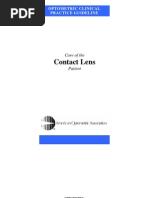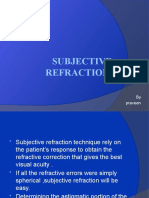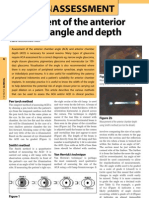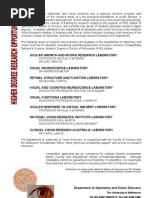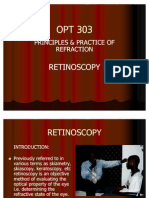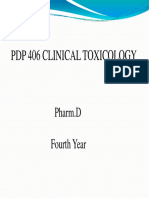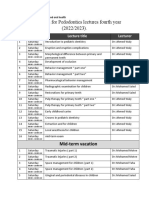Optometry Guidelines For Use of Scheduled Medicines
Optometry Guidelines For Use of Scheduled Medicines
Uploaded by
JLoCopyright:
Available Formats
Optometry Guidelines For Use of Scheduled Medicines
Optometry Guidelines For Use of Scheduled Medicines
Uploaded by
JLoOriginal Description:
Original Title
Copyright
Available Formats
Share this document
Did you find this document useful?
Is this content inappropriate?
Copyright:
Available Formats
Optometry Guidelines For Use of Scheduled Medicines
Optometry Guidelines For Use of Scheduled Medicines
Uploaded by
JLoCopyright:
Available Formats
Guidelines for use of scheduled medicines
9081
Guidelines for use of scheduled medicines
Contents
Authority 1 Purpose 1 Scope 1 1. Endorsement for scheduled medicines 1.1 Eligibility for endorsement 1.2 Approved programs of study and assessments 2. Use of scheduled medicines by optometrists 2.1 Quality use of medicines 2.2 Maintaining competence 2.3 Prescriptions 2.4 Practice procedures 2.5 Adverse event reporting 3. 4. Supply of scheduled medicines Guidelines for the use of topical antimicrobials 4.1 Microbial resistance 5. 6. Guidelines for the use of topical steroidal preparations Collaborative care guidelines 6.1 Role, responsibilities and communication in collaborative care of patients 6.2 Patient involvement 7. Guidelines for care of patients with, or at high risk of developing, chronic glaucoma 7.1 Equipment 7.2 Emergency management of acute primary angle closure 1 1 1 1 2 2 2 2 2 3 3 3 3 4 4 4 4 5 5
Review 5 Appendix A Approved programs of study and assessments for the purpose of endorsement for scheduled medicines Appendix B List of scheduled medicines approved by the Optometry Board of Australia for administration by optometrists holding general registration Appendix C Board-approved list of Schedule 4 medicines Appendix D First aid for acute angle-closure event 8 6
Guidelines for use of scheduled medicines
Authority
The Optometry Board of Australia (the Board) has developed these Guidelines for use of scheduled medicines under section 39 of the Health Practitioner Regulation National Law, as in force in each state and territory (the National Law). National Board guidelines describe the professional standards the Board expects of registered practitioners. They may be used to indicate appropriate professional conduct or practice in proceedings involving health practitioners under the National Law.
The Board considers optometrists whose registration is endorsed for scheduled medicines to be qualified and competent to: obtain, possess, administer, prescribe or supply specified scheduled medicines, and use those medicines appropriately for the treatment of conditions of the eye.
Purpose
These guidelines outline the Boards expectations in relation to the use of scheduled medicines by endorsed and non-endorsed optometrists.
Optometrists who hold this endorsement may only possess, prescribe or supply Schedule 4 medicines to the extent authorised under the legislation that applies in the state or territory in which they practise. Information will be published on the Boards website about the authorities that apply in each state and territory of Australia.
1.1 Eligibility for endorsement
To be eligible for an endorsement for scheduled medicines, an applicant must, in accordance with the Endorsement for scheduled medicines registration standard, have successfully completed: an approved program of study in ocular therapeutics OR a program of study determined by the Board to be substantially equivalent to an approved program of study OR a Board-approved examination or assessment in ocular therapeutics.
Scope
The guidelines apply to: optometrists with general registration who use scheduled medicines for diagnostic purposes, and optometrists whose registration is endorsed for scheduled medicines, who use scheduled medicines therapeutically to manage eye conditions independently and collaboratively with other healthcare practitioners.
Under the Boards Code of conduct for optometrists, optometrists have a responsibility to recognise and work within the limits of their competence and scope of practice. This includes ensuring they have the equipment, expertise and skills necessary to practise safely and effectively.
1.2 Approved programs of study and assessments
Information about currently approved programs of study and assessments is contained in Appendix A Approved programs of study and assessments for the purpose of endorsement for scheduled medicines.
1. Endorsement for scheduled medicines
Under section 94 of the National Law, the Board may endorse the registration of suitably qualified optometrists to prescribe scheduled medicines1. Table 1 of the Boards Endorsement for scheduled medicines registration standard lists the Schedule 4 medicines that optometrists with this endorsement are qualified to obtain, possess, administer, prescribe or supply for topical use. (Refer to Table C1 of Appendix C of these guidelines.)
2. Use of scheduled medicines by optometrists
In all Australian states and territories, optometrists with general registration are permitted to obtain, have in their possession and use scheduled medicines in the course of their practice for diagnostic purposes (for example anaesthetic and mydriatic eye drops). Appendix B of these guidelines lists the scheduled medicines approved by the Board for administration for diagnostic purposes by optometrists holding general registration. An endorsement is not required for an optometrist to use diagnostic medicines in the course of their practice.
The term scheduled medicine is a substance included in a schedule to the current Poisons Standard within the meaning of the Therapeutic Goods Act 1989 (Cth).
Guidelines for use of scheduled medicines
2.1 Quality use of medicines
Optometrists who prescribe scheduled medicines should observe the Quality Use of Medicines (QUM)2 principles. Quality use of medicine means: (a) selecting management options wisely by: considering the place of medicines in treating illness and maintaining health, and recognising there may be better ways than medicine to manage many disorders.
2.3 Prescriptions
Optometrists whose registration is endorsed for scheduled medicines must ensure that, when authorising the supply of a Schedule 4 medicine to a patient, the prescription is handwritten or computer generated. When prescribing a Schedule 2 or 3 medicine, the Board encourages endorsed optometrists to issue a prescription, to help ensure effective communication with the pharmacist. Prescriptions must be handwritten or computer generated and include the: date of issue details of the prescriber, patient, medicine (including name, strength and quantity) precise directions (except when directions are too complex and are provided separately, or when administration is to be carried out by a nurse or other person instructed and authorised to administer), and the prescribers signature.
(b) choosing suitable medicines (if a medicine is considered necessary) so that the best available option is selected by taking into account: the individual the clinical condition risks and benefits dosage and length of treatment any coexisting conditions other therapies monitoring considerations, and costs for the individual, the community and the health system as a whole.
The Board advises against endorsed optometrists selfdiagnosing and then self-prescribing schedule 4 medicines.
2.4 Practice procedures
Optometrists should ensure that: scheduled medicines are stored securely and in accordance with the manufacturers recommendations and as required under the legislation of the relevant jurisdiction details of in-practice administration of scheduled medicines are recorded on the patients clinical record and if required under the legislation of the jurisdiction, relevant authorities are notified of the loss or theft of a scheduled medicine.
(c) using medicines safely and effectively to get the best possible results by: monitoring outcomes minimising misuse, over-use and under-use improving peoples ability to solve problems related to medication, such as negative effects, and managing multiple medications.
2.2 Maintaining competence
All optometrists are expected to maintain their competence through continuing professional development, and need to meet the requirements set out in the Boards Continuing professional development registration standard.3 This standard also outlines the specific requirements to be met by optometrists whose registration is endorsed for scheduled medicines.
2.5 Adverse event reporting
The Therapeutic Goods Administration (TGA) is part of the Australian Government Department of Health and Ageing, and is responsible for regulating therapeutic goods including medicines, medical devices, blood and blood products. The TGA also collects reports of adverse events associated with medicines and medical devices. Monitoring of adverse events allows the TGA to investigate and take action on medicines safety issues. Optometrists can assist the TGA in safeguarding public health by reporting all suspected adverse events
2 3
The complete strategy can be found at www.health.gov.au. Refer to the Registration Standards tab on the Boards website.
Guidelines for use of scheduled medicines
associated with medicines, particularly those associated with new products. This information forms an important part of the TGAs monitoring activities and plays a key role in helping identify potential relationships between a therapeutic good and a series of adverse events. When a link can be established, the TGA takes action to ensure that medicines available in Australia continue to meet appropriate standards of safety, efficacy and quality. Further information can be found on the TGA website www. tga.gov.au.
ocular infections that constitute true ocular emergencies and require immediate treatment identification of risk factors for ocular surface infections indications and mechanisms of referral for microbiological investigation, and interpretation of the results of microbiological investigation and appropriate management stratagems arising from these results.
3. Supply of scheduled medicines
The Board supports the view that the division of responsibility between an optometrist with scheduled medicines endorsement who prescribes (authorises the supply of a scheduled medicine), and a pharmacist who dispenses the scheduled medicine to the patient, provides an important check designed to safeguard patients. The expertise of the pharmacist in counselling patients is important in the follow-up care of the patient. This includes checking adherence to the prescribers instructions, confirming administration times and techniques, screening for adverse reactions, and referring back to the prescriber for further investigations or advice when required. Circumstances when it is permissible for an optometrist to prescribe and supply a scheduled medicine to a patient include an emergency, in remote areas or after hours, when access to a pharmacy is impractical, or when the particular drug or agent is not normally stocked by the pharmacy. Optometrists who choose to supply a scheduled medicine directly to a patient must meet the labelling and recordkeeping requirements of the jurisdiction in which they are practising, provide counselling about the use of the medicine, its side effects and potential interactions and, if available, provide a Consumer Medicines Information leaflet4.
4.1 Microbial resistance
Optometrists using antimicrobial preparations should understand all issues relating to the emergence of resistance by pathogenic organisms and mechanisms for limiting this. Selection of an antimicrobial should always involve consideration of the risk that microbial resistance could develop. In particular, treatment regimens should be avoided that could result in: inappropriate drug selection insufficient therapeusis (i.e. drug regimen inadequate to control infection, either in duration or therapeutic effect) overuse, or inappropriate dosage.
At present, fluoroquinolones have broad-spectrum activity with relatively little microbial resistance. To maintain maximal efficacy of these preparations, fluoroquinolones should not be used when alternative, equally effective agents could be used instead. Optometrists should consider a specialist opinion for patients who may require long-term antimicrobial use.
5. Guidelines for the use of topical steroidal preparations
Optometrists seeking to treat ocular inflammation with scheduled medicines must have a clear understanding of the: immunological processes relevant to inflammatory conditions of the eye and their natural histories typical presentations of inflammatory conditions of the eye and the differential diagnoses of these from other anterior eye conditions inflammatory conditions of the eye that constitute true ocular emergencies and require immediate treatment identification of risk factors for developing ocular inflammation
4. Guidelines for the use of topical antimicrobials
All optometrists treating anterior eye infections with scheduled medicines must have a clear understanding of: microbiological and pathological processes relevant to anterior eye infection and their natural histories typical presentations of ocular surface infections and the differential diagnoses of these from other anterior eye conditions
Consumer Medicines information sheets are available at www.medicines.org.au.
Guidelines for use of scheduled medicines
potential side effects of topical steroid preparations, including a propensity for raising intraocular pressure in susceptible individuals and the potential development of cataract, and management strategies for steroid-related intraocular pressure rises.
the roles and responsibilities of each person participating in the shared care.
Optometrists should consider referral for a specialist opinion for those patients who may require long-term steroid use.
The Board recommends the use of protocols and forms to clarify responsibilities and facilitate the transfer of information and communication between practitioners. Such systems may involve standardised forms used by all parties participating in the arrangement or may be a less regimented agreement that each party will provide or forward a report to others after each consultation with the patient.5 Ongoing discussion between the optometrist and the other treating practitioner(s) should involve reviewing these protocols and making changes necessary over time to ensure optimal care of the patient.
6. Collaborative care guidelines
For the purpose of these guidelines, collaborative care is when the care of a patient is provided by two or more health practitioners, each practising within their sphere of expertise in consultation with the patient. Various collaborative care relationships between health care practitioners exist, ranging from ad hoc to formal, documented shared-care agreements. For eye conditions, shared care is likely to vary according to the location of the patient and the skill-base of local health care practitioners. The Boards Code of conduct for optometrists provides further guidance on communication with patients and other health practitioners.
6.2 Patient involvement
In any collaborative care arrangement, patients must consent to the arrangement and be clearly informed about who is responsible for their primary eye care and when they are required to attend reviews with each practitioner. Patients must be provided with the opportunity to choose whether they wish their care to be shared between an optometrist and health practitioner(s). Written information for patients about collaborative care may prove a useful addition to verbal discussions with treating practitioners.
6.1 Role, responsibilities and communication in collaborative care of patients
Within any collaborative care arrangement, it is essential that the roles and responsibilities of the optometrist and the other health practitioner(s) are defined clearly and continue to be redefined over time. Communication is the linchpin of effective collaborative care. Participating practitioners and their patients must understand which practitioner is responsible for providing the various aspects of care. To avoid repetition and confusion, each party must have a clear understanding of: the diagnoses, treatment(s) and ongoing recommendations to the patient of the other treating practitioners the information to provide to other parties involved in the care of the patient time frames in which this information should be provided the preferred format for this information who is responsible for ongoing patient care and the follow-up of patients who miss scheduled appointments, and
7. Guidelines for care of patients with, or at high risk of developing, chronic glaucoma
The following guidelines for care of patients with, or at high risk of developing, chronic glaucoma should be read in conjunction with: section 6 of these guidelines, Collaborative care guidelines National Health and Medical Research Council of Australias (NHMRC) Guidelines for the screening, prognosis, diagnosis, management and prevention of glaucoma 2010 (the NHMRC Guidelines) 6, and A guide to glaucoma for primary health care providers - a companion document to the NHMRC Guidelines for the screening, prognosis, diagnosis, management and prevention of glaucoma 7.
Optometrists Association Australia has published a position statement on Shared Care. This may inform the development of such protocols and or forms. Published at www.nhmrc.gov.au/guidelines/publications/ cp113-cp113b.
7 ibid.
Guidelines for use of scheduled medicines
The NHMRC Guidelines and the companion document outline a series of recommendations and supporting evidence for all practitioners involved in the screening, prognosis, diagnosis, management and prevention of glaucoma. In terms of collaborative care of patients with glaucoma, the Board endorses the recommendation from the NHMRC Guidelines that the professional roles, responsibilities and referral pathways are best determined in individual cases based on location, resources, skill-base of local health care practitioners and patient choice.8 When a diagnosis of chronic glaucoma is made, or a patient is at high risk of developing the disease, optometrists whose registration is endorsed for scheduled medicines must: refer the patient for specialist assessment and advice about ongoing management, or develop a management plan that includes initiation of treatment and monitoring of the patients response.
7.1 Equipment
To comply with these guidelines, optometrists must have the equipment to measure and/or assess a patients intraocular pressure, central corneal thickness, threshold visual fields, anterior chamber angle, optic nerve head and retinal nerve fibre layer. Optometrists should refer specifically to the sections on Diagnosis of glaucoma and Monitoring: long-term care in the NHMRC Guidelines.
7.2 Emergency management of acute primary angle closure
Individuals suffering from an acute angle-closure event may present to an optometrist or, rarely, an angle-closure event may be induced through routine pupil dilation. The standard management of such a patient is emergency referral to an ophthalmologist or hospital. However, both the nature of the condition and endorsement for scheduled medicines enable the optometrist to, in collaboration with a medical practitioner, provide first aid for such patients to stabilise their ocular state (refer to Appendix D of this document for suggested first aid for an angle-closure event). As the definitive intervention in acute angle closure is procedural intervention (laser therapy), the optometrist should seek ophthalmological input, if possible, before administering first aid to lower intraocular pressure and reduce pain. Exceptions to this include when an ophthalmologist cannot be contacted and the best interests of the patient are served by initiating treatment before emergency referral to the most convenient ophthalmologist or hospital.
Instillation of anti-glaucoma eye drops is the preferred primary intervention in chronic glaucoma management9 however, in certain cases patients will need initial assessment by an ophthalmologist for possible surgical intervention or laser treatment. Optometrists must be able to identify those cases and refer where appropriate. Optometrists should refer to the NHMRC Guidelines when setting target intra-ocular pressures and when making decisions about glaucoma management plans, including the frequency of review appointments. The patients risk factors for progression, their disease state and capacity to self-manage will dictate the frequency of review10. Referral for ophthalmological assessment and advice must be considered if the anti-glaucoma treatment does not stabilise the patients condition. The Board expects that optometrists managing patients with glaucoma will maintain regular communication with the patients general practitioner, ophthalmologist, physician or other health care practitioner. Clear communication between practitioners is crucial to ensure each practitioner understands who is responsible for providing each aspect of the patients care.
Review
The Board will monitor this guideline for effectiveness and review it at least every three years. This guideline replaces any previously published National Board guidelines on use of scheduled medicines. Date of issue: 21 March 2013. Last reviewed: 21 March 2013.
National Health and Medical Research Council of Australias (NHMRC) Guidelines for the screening, prognosis, diagnosis, management and prevention of glaucoma 2010, p. 83 www.nhmrc. gov.au/guidelines/publications/cp113. NHMRC Guidelines, p. 108.
10 NHMRC Guidelines, p. 91.
Guidelines for use of scheduled medicines
Appendix A
Approved programs of study and assessments for the purpose of endorsement for scheduled medicines
The Board accepts the following qualifications and assessments for endorsement for scheduled medicines.
Approved programs of study
A list of approved programs of study accredited by the Optometry Council of Australia and New Zealand (OCANZ) is at www.optometryboard.gov.au/Accreditation. Approved programs include: those that lead to qualification for general registration and endorsement for scheduled medicines, and postgraduate courses in ocular therapeutics that qualify for endorsement for scheduled medicines.
Overseas-trained optometrists
Optometrists currently registered in Australia who trained outside Australia and New Zealand and who have or have had therapeutic prescribing rights in their country of training, may have their registration endorsed to prescribe medicines by successfully completing the Assessment of Competence in Ocular Therapeutics (ACOT) examination. This is conducted by the Optometry Council of Australia and New Zealand (OCANZ). Information about ACOT can be found on the OCANZ website at http://www.ocanz.org.
Inactive programs of study
Ocular therapeutics courses conducted between 2001 and 2005 and granted accreditation by the Optometrists Registration Board of Victoria are also approved by the Optometry Board of Australia.
Guidelines for use of scheduled medicines
Appendix B
List of scheduled medicines approved by the Optometry Board of Australia for administration by optometrists holding general registration
The Optometry Board of Australia has approved the following diagnostic drugs for optometrists to administer in the course of their practice: anaesthetics, local (synthetic cocaine substitutes) when prepared and packed in the form of eye drops tropicamide when prepared and packed in the form of eye drops containing one (1) per cent or less of tropicamide cyclopentolate hydrochloride when prepared and packed in the form of eye drops containing one (1) per cent or less of cyclopentolate hydrochloride atropine when prepared and packed in the form of eye drops containing one (1) per cent or less of atropine sulphate homatropine when prepared and packed in the form of eye drops containing two (2) per cent or less of homatropine hydrobromide pilocarpine nitrate when prepared and packed in the form of eye drops containing two (2) per cent or less of pilocarpine nitrate physostigmine salicylate when prepared and packed in the form of eye drops containing 0.5 per cent or less of physostigmine salicylate.
Registered optometrists should be familiar and comply with the current requirements of state and territory drugs and poisons legislation in the jurisdictions in which they practise. The Board will publish on its website a list of authorities that apply in each state and territory.
Guidelines for use of scheduled medicines
Appendix C
Board-approved list of Schedule 4 medicines
Under section 94 of the National Law, the Board may endorse the registration of eligible optometrists as qualified to obtain, possess, administer, prescribe or supply the scheduled medicines used in the treatment of conditions of the eye, included in the list below.11 Table C1 lists the Schedule 4 medicines that have been approved for use by optometrists whose registration has been endorsed by the Board. This is a duplicate of the list published in the Boards Endorsement for scheduled medicines registration standard. For an optometrist to possess, prescribe, supply or use these Schedule 4 medicines in a particular jurisdiction, the authorisation must be provided for by enactment of legislation in that jurisdiction. Registered optometrists should be familiar and comply with the current requirements in the jurisdictions in which they practise. The Board will publish on its website a list of authorities that apply in each state and territory. Table C1 Board-approved list of Schedule 4 poisons that optometrists with a scheduled medicines endorsement are qualified to obtain, possess, administer, prescribe or supply for topical use
Anti-infectives Anti-inflammatories Anti-glaucomas Miotics, mydriatics and cycloplegics Atropine Cyclopentolate Homatropine Pilocarpine Phenylephrine Tropicamide
Aciclovir Azithromycin Bacitracin Cephazolin Chloramphenicol1 Ciprofloxacin Framycetin Gentamicin Gramicidin Neomycin Ofloxacin Polymyxin Tetracycline Tobramycin Vidarabine
Cyclosporin Dexamethasone Diclofenac Fluorometholone Flurbiprofen Hydrocortisone Ketorolac Prednisolone
Apraclonidine Betaxolol Bimatoprost Brimonidine Brinzolamide Carbachol Diprivefrin Dorzolamide Latanoprost
Local anaesthetics Amethocaine Lignocaine Oxybuprocaine Proxymetacaine
Decongestants/ anti-allergics Olopatadine
Levobunolol Pilocarpine Timolol Travoprost
11 Refer to the Boards Endorsement for scheduled medicines registration standard published under the Registration Standards tab of the Boards website.
Guidelines for use of scheduled medicines
Appendix D
First aid for acute angle-closure event
The following immediate interventions are suggested, unless otherwise contraindicated in a given patient, for the emergency management of acute primary angle closure. Optometrists whose registration is endorsed for scheduled medicines are not currently authorised under state and territory drugs and poisons legislation to prescribe, possess or supplyacetazolamide(Diamox). In urgent cases, and when permitted bylegislationin the relevant jurisdiction, a pharmacist can supplyDiamoxto the patient when requested to do so via a telephone order froma medical practitioner.Optometristsare advised toliaise with a medical practitioner to arrange the supply ofDiamoxfor the patient. (a) An oral dose of acetazolamide 500mg (Diamox) can be administered provided there are no contraindications. If Diamox cannot be tolerated orally, the patient is likely to require intramuscular or intravenous administration of Diamox and/or treatment with other therapeutic agents. In this situation, referral and transfer to an ophthalmologist or hospital emergency department should occur without delay. (b) Instil the following topical medications (allowing approximately two minutes between each drop): One (1) drop beta-blocking agent (e.g. timolol, 0.5 per cent). One (1) drop alpha agonist (e.g. apraclonidine, 0.5 per cent). One (1) drop carbonic anhydrase inhibitor (e.g. brinzolamide, 1.0 per cent). If the eye is red and inflamed, one (1) drop highpenetrance topical steroid with the optometrist or patient to instil a further three (3) drops at regular intervals in the first hour, then hourly thereafter.
Note: Pilocarpine should only be used for mechanisms involving phakic pupillary block or angle crowding; use of pilocarpine is contraindicated for retrolenticular causes of angle closure as well as those involving aphakic or pseudophakic closure events.
It is preferable to withhold instillation of pilocarpine until the IOP has been reduced (except in the rare instance of an angle-closure event being caused through routine pupil dilation, in which case instillation of pilocarpine should commence immediately). (c) Just before the patient is transferred, and after discussion with the ophthalmologist confirming that instillation of pilocarpine is indicated, instil: One (1) drop pilocarpine, 2 per cent (with the optometrist or patient to instil a further drop in 15 minutes).
You might also like
- OCANZ 93 SHORT-questions-100-correct-answersDocument28 pagesOCANZ 93 SHORT-questions-100-correct-answersNikhil PaulNo ratings yet
- Ocanz Skills Examination Practice ManualDocument38 pagesOcanz Skills Examination Practice ManualMidhun P. Mathew100% (2)
- OCANZ Sept 2007 Paper 1Document4 pagesOCANZ Sept 2007 Paper 1Ben Joon50% (2)
- Visual Requirements For Driving: by Catharine Chisholm PHD Mcoptom, University of BradfordDocument5 pagesVisual Requirements For Driving: by Catharine Chisholm PHD Mcoptom, University of Bradfordagisab100% (2)
- OCANZ 220-MCQ Questions-100-Correct-AnswersDocument18 pagesOCANZ 220-MCQ Questions-100-Correct-AnswersNikhil Paul100% (1)
- RCUK Paediatric Emergency Algortihms and Resources Jan 23 V2Document15 pagesRCUK Paediatric Emergency Algortihms and Resources Jan 23 V2Essam HassanNo ratings yet
- Delost Introduction To Diagnostic Microbiology 390 392Document3 pagesDelost Introduction To Diagnostic Microbiology 390 392Keanne GanironNo ratings yet
- Sample Short Answer Questions SAQsDocument1 pageSample Short Answer Questions SAQsVikash shuklaNo ratings yet
- OptoPrep Part1 StudyCalendar 6-Month PDFDocument7 pagesOptoPrep Part1 StudyCalendar 6-Month PDFmelanieNo ratings yet
- CPG 19Document78 pagesCPG 19anon-24970100% (1)
- Ophthalmology CurriculumDocument71 pagesOphthalmology CurriculumEdoga Chima EmmanuelNo ratings yet
- The Clinical, Microbial, and Host Response Characteristics of The Failing ImplantDocument19 pagesThe Clinical, Microbial, and Host Response Characteristics of The Failing ImplantMedstudNo ratings yet
- Ocanz Past PapersDocument6 pagesOcanz Past PapersSiddhartha Shankar NagNo ratings yet
- Amy Pillay April 2017Document3 pagesAmy Pillay April 2017Chino Nledum100% (1)
- OCANZ Sept 2007 Paper 2Document4 pagesOCANZ Sept 2007 Paper 2Ben Joon100% (4)
- Optometric ManagementDocument4 pagesOptometric Managementirijoa100% (1)
- Subjective Refraction: by PraveenDocument61 pagesSubjective Refraction: by PraveenHenok Biruk100% (1)
- Subjective RefractionDocument21 pagesSubjective RefractionSafeet Shahbaz100% (1)
- Retinoscopy: Moderator:-Dr. Jyoti PuriDocument33 pagesRetinoscopy: Moderator:-Dr. Jyoti PuriSafa Abdualrahaman Ali HamadNo ratings yet
- Concomitant SquintDocument21 pagesConcomitant SquintShivani Nair100% (2)
- Module 5 - Ocular Motility - Cover TestDocument12 pagesModule 5 - Ocular Motility - Cover TestCat Loved Kirari100% (2)
- Ico Inst BK Optics 2015Document16 pagesIco Inst BK Optics 2015Safa Abdualrahaman Ali HamadNo ratings yet
- Viva GuideDocument27 pagesViva GuideCHIMA ONWUKA MONGNo ratings yet
- Smith Test, Goniolens, Shadow TestDocument3 pagesSmith Test, Goniolens, Shadow TestJLo100% (1)
- Case Study PediatricDocument7 pagesCase Study PediatricJoshua Havana100% (2)
- Investigation in OptometryDocument10 pagesInvestigation in Optometryrapid73No ratings yet
- Opinioes Exames Ebo e IcoDocument8 pagesOpinioes Exames Ebo e Icoapi-3595301060% (1)
- Pediatric Ophthalmology Anatomy and ExaminationDocument21 pagesPediatric Ophthalmology Anatomy and ExaminationGlydenne GayamNo ratings yet
- Case Studies PresbyopiaDocument33 pagesCase Studies PresbyopiaMalaika Zubair100% (1)
- Refractive Errors: Dr. Leow Thye YngDocument55 pagesRefractive Errors: Dr. Leow Thye YngRaissa100% (1)
- Aspheric Lenses - Optometry TodayDocument4 pagesAspheric Lenses - Optometry TodaySourav KarmakarNo ratings yet
- Strabismus - A Decision Making Approach (G Noorden)Document197 pagesStrabismus - A Decision Making Approach (G Noorden)Raluca OpreaNo ratings yet
- 07 Crossed Eyes Nystagmus and AmblyopiaDocument7 pages07 Crossed Eyes Nystagmus and AmblyopiaMwanja MosesNo ratings yet
- Opt 303Document54 pagesOpt 303Emmanuel Abu100% (2)
- Guia para Estudiar para IcoDocument16 pagesGuia para Estudiar para IcoMaria Silvana Sequera LampeNo ratings yet
- Clinical Case in Contact Lenses, 1e - 2001Document205 pagesClinical Case in Contact Lenses, 1e - 2001Miguel Palacios100% (1)
- Pediatric OptometryDocument14 pagesPediatric OptometryDaman Fatima100% (1)
- Third Years Log BookDocument11 pagesThird Years Log BookMeenakshi Kumar100% (2)
- Perimetry-Reading A Sinsle FieldDocument69 pagesPerimetry-Reading A Sinsle FieldMayank JainNo ratings yet
- Nungki-Esodeviations & ExodeviationsDocument36 pagesNungki-Esodeviations & ExodeviationsNia RoosdhantiaNo ratings yet
- Cover TestDocument2 pagesCover Testmksharmaa100% (1)
- Accommodation Dysfunction: DR Neelu AgrawalDocument30 pagesAccommodation Dysfunction: DR Neelu AgrawalNeelu MundhadaAgrawalNo ratings yet
- RGP Fitting +++++Document18 pagesRGP Fitting +++++Philip McNelsonNo ratings yet
- Anomalie VisionDocument13 pagesAnomalie Visionblueice100% (1)
- Cycloplegic Retinoscopy in InfancyDocument5 pagesCycloplegic Retinoscopy in InfancyStrauss de LangeNo ratings yet
- Strabismus: By: Audra Bishop Beth Moline Elisabeth CohenDocument60 pagesStrabismus: By: Audra Bishop Beth Moline Elisabeth CohenmalathiNo ratings yet
- Strabismus and Diplopia After Refractive SurgeryDocument5 pagesStrabismus and Diplopia After Refractive Surgeryyuda saputraNo ratings yet
- Types of Amblyopia - American Academy of OphthalmologyDocument1 pageTypes of Amblyopia - American Academy of OphthalmologyIraNo ratings yet
- Convergence Insufficiency - EyeWikiDocument4 pagesConvergence Insufficiency - EyeWikiskline3No ratings yet
- Ico Inst BK Visual SC 2018 Rev2Document20 pagesIco Inst BK Visual SC 2018 Rev2drlawrencekindoNo ratings yet
- Clinical Optometry Related FilesDocument14 pagesClinical Optometry Related FilesHasan AnsariNo ratings yet
- Clinical Assessment GuideDocument2 pagesClinical Assessment GuideSim Pei YeeNo ratings yet
- Slit LampDocument23 pagesSlit LampShubhangi ShuklaNo ratings yet
- Dispensing 204 Tutorial 201-1Document2 pagesDispensing 204 Tutorial 201-1Basildon MukorombindoNo ratings yet
- Rana Al-Senawi - Arab Board 2014 Exam ExprinceDocument5 pagesRana Al-Senawi - Arab Board 2014 Exam ExprinceMuhammed AbdulmajeedNo ratings yet
- Prescription WritingDocument26 pagesPrescription WritingShaHiL HuSsAin100% (2)
- Interactive Quiz Visual Optics 1: Mcqs. Among The Following Choices One Is CorrectDocument2 pagesInteractive Quiz Visual Optics 1: Mcqs. Among The Following Choices One Is CorrectALi SaeedNo ratings yet
- MCQ 05 OpticsDocument14 pagesMCQ 05 OpticsAmr Abdulradi0% (1)
- Low Vision PrinciplesDocument272 pagesLow Vision Principlesmariam mhNo ratings yet
- Dispensing AnisometropiaDocument28 pagesDispensing Anisometropiahenok biruk100% (2)
- Soft Multifocal Simultaneous Image Contact Lenses A ReviewDocument21 pagesSoft Multifocal Simultaneous Image Contact Lenses A ReviewBAYUNo ratings yet
- The Jackson Cross Cylinder TestDocument4 pagesThe Jackson Cross Cylinder TestDaniDenzongpaSulaemanNo ratings yet
- The Skeffington Perspective of the Behavioral Model of Optometric Data Analysis and Vision CareFrom EverandThe Skeffington Perspective of the Behavioral Model of Optometric Data Analysis and Vision CareNo ratings yet
- Examination of The Patient - StereopsisDocument10 pagesExamination of The Patient - StereopsisJLoNo ratings yet
- Cclru Grading ScaleDocument2 pagesCclru Grading ScaleJLoNo ratings yet
- Wall HangerDocument4 pagesWall Hangervinoedhnaidu_rajagopalNo ratings yet
- Smith Test, Goniolens, Shadow TestDocument3 pagesSmith Test, Goniolens, Shadow TestJLo100% (1)
- Aging Vit Struct 1987Document5 pagesAging Vit Struct 1987JLoNo ratings yet
- 35.1 - The Digestive SystemDocument16 pages35.1 - The Digestive SystemMostafa Galal El Din100% (1)
- 21 Reasons Why You Should Have Sex and The Advantages To Our HealthDocument12 pages21 Reasons Why You Should Have Sex and The Advantages To Our Healthnelson100% (1)
- ART Side Effects - pocketguideSecondEdDocument119 pagesART Side Effects - pocketguideSecondEdnadia21ahmedNo ratings yet
- ER Nurse ResponsibilitiesDocument2 pagesER Nurse Responsibilitiesjasnate84No ratings yet
- Lecture Notes On EpidemiologyDocument196 pagesLecture Notes On Epidemiologypushpa devkota100% (1)
- Documentation of Red Flags by Physical Therapists For Patients With Low Back PainDocument8 pagesDocumentation of Red Flags by Physical Therapists For Patients With Low Back PainBwizerNo ratings yet
- Assessment of The Levels Ofcardiopulmonary Resuscitation (CPR) Among Medical Students in Northern Saudi ArabiaDocument9 pagesAssessment of The Levels Ofcardiopulmonary Resuscitation (CPR) Among Medical Students in Northern Saudi ArabiaIJAR JOURNALNo ratings yet
- Drug Administration Route Needle Size EtcDocument1 pageDrug Administration Route Needle Size EtcRon AbuNo ratings yet
- S3 CP3 UrinalysisDocument3 pagesS3 CP3 Urinalysis2013SecBNo ratings yet
- Thesis Topics in Veterinary PathologyDocument6 pagesThesis Topics in Veterinary Pathologybk4h4gbd100% (2)
- PDP 406 Clinical Toxicology: Pharm.D Fourth YearDocument18 pagesPDP 406 Clinical Toxicology: Pharm.D Fourth Yearabirami pNo ratings yet
- Fon 2019Document6 pagesFon 2019vanhmingachhangteNo ratings yet
- !lier: National Health Mission. OdishaDocument11 pages!lier: National Health Mission. OdishaMAHAMMAD ANWAR ALINo ratings yet
- Bio Energetic TherapyDocument19 pagesBio Energetic TherapyVishnu Moorthy Raja Singam100% (2)
- Cadila Healthcare LTDDocument16 pagesCadila Healthcare LTDchrg17592No ratings yet
- Case History in Complete Denture PatientsDocument35 pagesCase History in Complete Denture PatientsMaqbul AlamNo ratings yet
- UKHSA Vaccine Surveillance Report Week 48Document47 pagesUKHSA Vaccine Surveillance Report Week 48Al StatiliusNo ratings yet
- Roils Case StudyDocument3 pagesRoils Case Studyapi-483339757No ratings yet
- IV Cert CurriculumDocument1 pageIV Cert CurriculumBhuvaneshwariNo ratings yet
- 23rglmgb2punhj3tbk4mpfhzDocument1 page23rglmgb2punhj3tbk4mpfhzHarsh AryaNo ratings yet
- Christine P. SalimbagatDocument2 pagesChristine P. SalimbagatChristine Pialan SalimbagatNo ratings yet
- Myasthenia GravisDocument3 pagesMyasthenia Gravisdmnd_cdNo ratings yet
- Needle Stick Injyry PolicyDocument16 pagesNeedle Stick Injyry PolicyJery JsNo ratings yet
- Bacteriology Mtap (Part1)Document8 pagesBacteriology Mtap (Part1)Joshua CayagoNo ratings yet
- بيدوDocument2 pagesبيدوlove youNo ratings yet
- Microbiology Paper IDocument24 pagesMicrobiology Paper Iunig3333No ratings yet
- FullDocument12 pagesFulljuan carlosNo ratings yet









